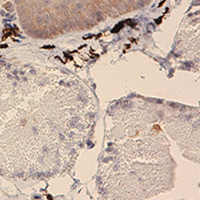Immunoreactivities of AR, ERα, ERβ and aromatase in the nuptial pad of Chinese brown frog (Rana dybowskii) during pre-hibernation and the breeding period

Accepted: 25 March 2021
HTML: 25
All claims expressed in this article are solely those of the authors and do not necessarily represent those of their affiliated organizations, or those of the publisher, the editors and the reviewers. Any product that may be evaluated in this article or claim that may be made by its manufacturer is not guaranteed or endorsed by the publisher.
Authors
There is a prominent local raised pad called nuptial pad on the forelimb of Chinese brown frog (Rana dybowskii), which is hypothetically concluded as an enhancement of the grip and a spreader of pheromone during the amplexus. In this study, we investigated the immunolocalization and protein expression levels of AR, ERα, ERβ and aromatase in the nuptial pad of R. dybowskii during pre-hibernation and the breeding period. Histologically, the annual development of the nuptial pad in R. dybowskii is manifested as the larger area of specialized mucous gland and the longer length of papillary epidermal projection during the breeding period. AR, ERα, ERβ and aromatase are present in the stratum granulosum, stratum spinosum, stratum basale and the secretory portion of specialized mucous glands during both periods. Western blotting results confirmed that AR, ERα and ERβ protein levels are higher during pre-hibernation than those during the breeding season. These results suggest that nuptial pad is the direct target organ of androgen and estrogen. Androgen may participate in the regulation of annual development and glandular function of nuptial pad, and estrogen may play an endocrine, autocrine or paracrine role during pre-hibernation and the breeding period.
How to Cite
PAGEPress has chosen to apply the Creative Commons Attribution NonCommercial 4.0 International License (CC BY-NC 4.0) to all manuscripts to be published.

 https://doi.org/10.4081/ejh.2021.3206
https://doi.org/10.4081/ejh.2021.3206






